About 30 years ago, osteochondrosis was associated exclusively with elderly people, whose joints become inactive and hurt with each movement. However, times have changed. Today, more and more people are changing hard physical work for sedentary work on the computer, they are less and less monitoring the quality of food, and more and more often they find osteochondrosis of the Cervical Hotel. It is not surprising that osteochondrosis is called the "disease of the century", and almost all the people who have reached the age of 25 find the symptoms of this ailment.
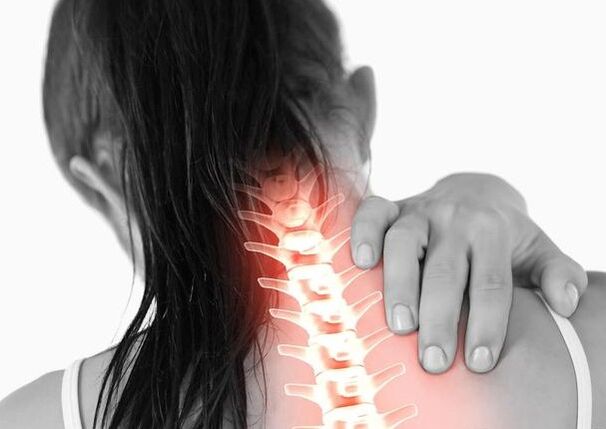
This is an insidious disease, which begins with unpleasant pain in the neck, very quickly leads to serious inverted consequences and weakening of the vision, as well as the worsening of memory until it is completely lost. That is why each person must know the causes of osteochondrosis and consult a doctor in a timely manner in case of unpleasant symptoms of the disease. We will talk about them in this article.
The causes of the osteochondrosis of the cervical region
Paradoxically, all our problems with the cervical column begin in early childhood, or rather in primary school, where the child deteriorates posture and scoliosis. It is at this time that the system of maintaining the head of the column is violated, in particular, the most subtle and vulnerable department: the cervical. The second key factor in the osteochondrosis of the cervical region, which begins in distant childhood, is insufficient physical preparation, in particular, the weakness of the spinal muscles and the muscular corset of so called designed to support the spine.
These are two most important causes of the disease. All the rest with a heavy load falls on a weakened column, causing the development of the disease in quite young and healthy people. First, they include a sedentary lifestyle and the lack of physical activity, in particular work, which is associated with a long stay in a position. This is more characteristic of drivers and office workers, replacing the computer. All this is complemented by excess body weight, which seriously increases the load in the spine.
Of the other causes of the osteochondrosis of the cervical column, it must be distinguished:
- transmitted column injuries;
- Metabolic violation;
- hereditary predisposition;
- Great physical effort;
- constant nerve tension and stress;
- anomalies in the development of the cervical column;
- Bad habits (holding the telephone tube with the ear and shoulder).
The osteochondrosis development process
The adverse factors listed ultimately lead to an increase in load in the cervical column. When it comes to compensating the excess load of the neck muscles, its spasm occurs, which leads to a violation of blood circulation in this area and a decrease in metabolic processes. All this becomes the development of degenerative processes in the spine. First, the vertebrae begin to be thinner and approach, squeezing their content (fibrous ring) out of the spine. Such protrusion in the language of doctors is called protrusion.
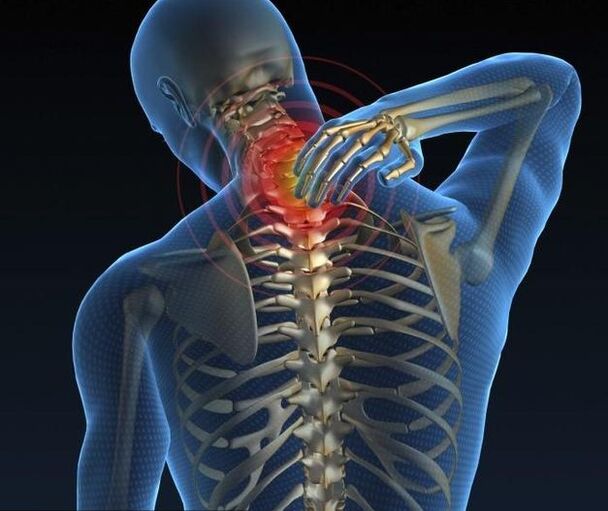
In the case of protuberance, the fibrous ring still retains its integrity, but the protuberance already squeezes the blood vessels and nerves that pass along the spinal column and feed the brain. In addition, convergent and deformed vertebrae begin to squeeze the roots of peripheral nerves, which leads to the development of the "root syndrome" called So, which manifests itself with severe pain on the back and neck. If you do not identify the problem (which unpleasant symptoms will be indicated eloquently) and do not begin to treat osteochondrosis, the fibrous ring will break and the vertebral hernia will appear. In this case, serious problems will arise with brain nutrition.
Cervical osteochondrosis symptoms
In its development, the disease passes several stages, each of which has characteristic characteristics and symptoms. It should be noted here that the osteochondrosis of the cervical column differs from degenerative changes in other parts of the column. The distances between the vertebrae here are minimal and, therefore, even small degenerative changes cause unpleasant symptoms and lead to various complications.
First degree osteochondrosis.This is the preclinical stage of the development of the disease, in which the patient experiences a slight pain and discomfort during the turns of the head, as well as the rapid tension and fatigue in the neck and back with a prolonged finding in a position (often in sedentary). At this stage, osteochondrosis is perfectly treated with a change in lifestyle, nutrition correction and regular physical exercises.
Osteochondrosis of Grade II.At this stage, instability appears between the vertebrae in the neck. In this case, a person faces intense pains, which are given to the shoulder, neck or hand. During the inclinations or turns of the head, the pain increases significantly, since due to a decrease in the distance between the vertebrae, the nerve endings begin to violate. The patient begins to get tired quickly, his performance is reduced, distraction, oblivion and torment of headaches appear.
Osteochondrosis of Grade III.With the beginning of the third stage of the disease, the pain in the back and the neck becomes even stronger, the mobility of the neck decreases markedly, and when turning the neck, a crunch of vertebrae can be heard. At night, the patient begins to fall asleep with the fingers (mainly a finger and ring finger), so a person wakes up several times per night. Throughout the day, such patients have unpleasant gravity in their hands. And even a brief conversation on the phone, in which a person is forced to hold a mobile near his ear, becomes an unpleasant tingling and numbness on his fingers. All this indicates an increase in bump, and possibly the appearance of a hernia in the cervical region.
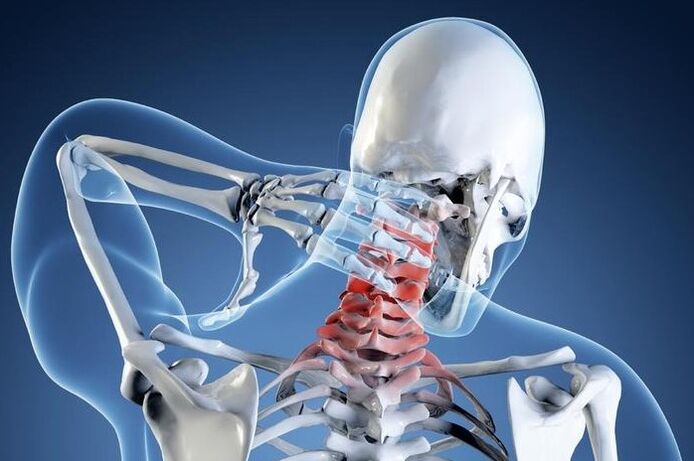
Osteochondrosis of Grade IV.In the last stage of the disease, vertebrates are destroyed, which stop performing their functions and begin to be replaced by connective tissue. A patient in this state can observe a violation of the coordination of the movement, a noise appears and the pulsation in the ears is crazy, the headaches increase, the visual acuity and the audition are reduced. In some cases, language numbness can be observed.
It should be said that due to the transfer of blood vessels, blood flow to the brain is altered. Because of this, the patient has neurotic disorders such as insomnia, nervousness, irritability and resentment, frequent humor changes and the inability to concentrate. The outbreaks of anger or fear can occur periodically, to attack desire and depression.
In the posterior stages of the development of osteochondrosis, the strongest cramps of blood vessels can lead to the appearance of "flies" in front of the eyes, a sense of instability on a hard and flat surface, strong dizziness, migraines, nausea, vomiting and fainting.
Disease diagnosis
To identify the cause of the pathology, the patient describes the unpleasant symptoms of the doctor of his condition. After listening to the patient, the specialist sends him to one of the following research methods.
Radiography.Currently, this diagnostic method is considered little informative, especially in the last stages of disease development.
Duplex scan of ultrasound. This method is used in cases where a specialist implies a violation of blood flow in the arteries that give the brain to food. The study shows the flow of blood and determines whether there are obstacles in its path.
CT (computerized tomography).This method is more informative compared to radiography, since it not only reveals the problem, but also allows it to determine the presence and size of hernias, although with difficulty.
MRI (magnetic resonance image).The most informative method for the diagnosis of osteochondrosis, which allows it to distinguish bone structures, the presence of hernias and even the direction of their development.
Osteochondrosis treatment
We will immediately say that to combat a problem as serious as the osteochondrosis of the cervical region, it must resort to a neurologist. It is true that if the clinic has a doctor in a vertebrologist, it is better to contact him first. You can only treat osteochondrosis thoroughly. The complex of the methods used includes pharmacological therapy, the massage of the cervical zone, exercise therapy, physiotherapeutic methods, as well as proper nutrition. Only the combination of all these methods will help deal with the disease and normalize the patient's well.
Help with severe pain
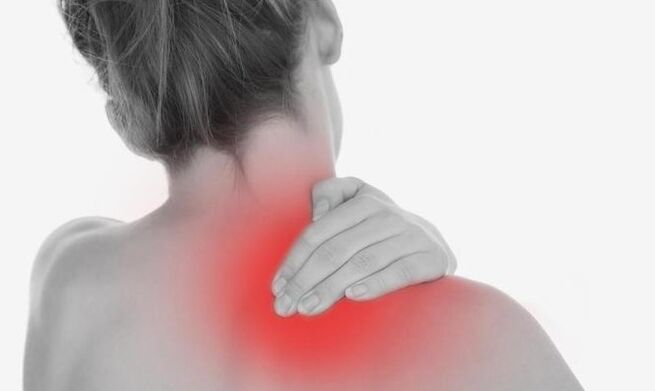
In the case of a strong pain syndrome, doctors recommend taking analgesics. When these funds stop generating relief, it can change to non -steroid anti -inflammatory medications.
In a general sense, pharmacological therapy includes the following funds:
- NSAID (non -steroidal anti -inflammatory drugs). These products eliminate pain, relieve swelling and face the inflammation of nerve roots.
- Condroprotectors. Such drugs perfectly restore damaged cartilage tissues.
- B Vitamins B. They are necessary to improve metabolic processes in nerve tissues.
- Musorelaxantes. The effect of these drugs aims to reduce muscle cramps.
- Preparations that improve the rheological properties of blood. Thanks to such means, oxygen flow and nutrients for the brain and nerve endings improve.
It should be noted here that it is possible to achieve a tangible effect on the fight against osteochondrosis using ointments and tablets only if medication treatment is combined with other therapy methods. Otherwise, drugs will only give a temporary effect.
Many experts tend to treat osteochondrosis with injections to quickly affect nerve endings and save the patient from possible side effects when taking tablets. However, vitamins are taken better orally, because the body absorbs vitamins well with any method of taking, but injections with them can be painful.
Methods of physiotherapeutic treatment
Medication treatment should be combined with physiotherapeutic methods of therapy. The most effective in this disease are considered:
- Electrophoresis (in drug combination). The medications in this case penetrate the damaged vertebrae under the influence of the electric current.
- Ultrasound. This exposure method allows you to relieve the inflammatory process, calm pain and improve metabolic processes in tissues.
- MagnetotherapyThis type of physiotherapy relieves swelling and eliminates pain.
- Laser therapy. This is a great method to combat inflammatory processes, which also improves blood circulation.
Osteochondrosis diet
The restoration of the affected vertebrae also includes a special diet that normalizes the metabolic processes in the body, avoids the deposition of salts, nourishes and restores the tissue of the cartilage and also strengthens the ligaments between vertebrates.
To achieve this, first of all, the patient's diet should be excluded:
- alcoholic beverages;
- fat and fried dishes;
- Sharp and too salty dishes;
- strong broth;
- Weaknesses and Sdoba;
- strong tea and coffee;
- pickles and marinades;
- Canned products.
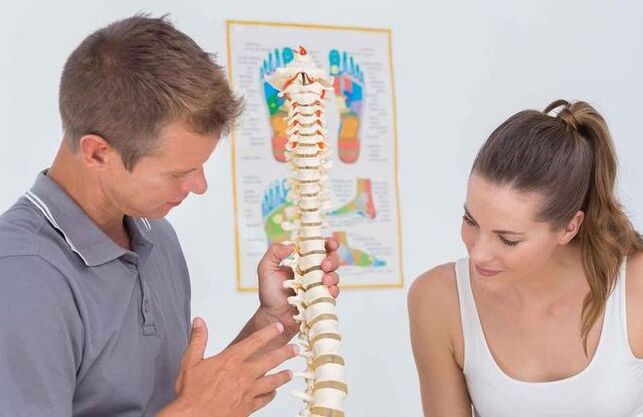
The diet of a patient with osteochondrosis should consist of the following foods:
- low -fat meat and fish;
- Low fat, cottage cheese and kefir;
- butter (in small quantities);
- entire cereal cereals and soups;
- gelatin, pouring fish or meat;
- vegetables, fruits and berries;
- Jues, fruit drinks, jelly and compote.
When locating osteochondrosis in the cervical region, it is important to adhere to the drink regime, drinking at least 1, 5 liters of water per day. If there is overweight, then you should think about how to get rid of additional pounds that provide an additional load in the spine. It is advisable to change to energy 5 times a day in small portions.
At the same time, as can be seen in the list of products allowed for use, the base of food must be vegetarian soups of low fat, boiled meat without fat, fish, shellfish, vegetables and sugar without sugar.
The approximate menu for the day will be seen as follows:
- Breakfast: cottage cheese, apple torque, sugar -free tea;
- Lunch: baked pear, a small oatmeal;
- Lunch: vegetarian borsch, boiled chicken with vegetable salad;
- Jocura of the afternoon: dried cookies and fruits fruits;
- Dinner: baked fish with vegetables and sugar -free tea.
Exercise therapy for osteochondrosis
Physical education gives surprising results in the treatment of osteochondrosis, the truth is to participate in gymnastics for the cervical column only during the recovery period. Here it is important that in the massage or gymnastics process, the patient does not experience discomfort and pain.

Here are some more effective gymnastic exercises aimed at strengthening cervical muscles and improving blood circulation in this area.
Exercise number 1Lying on the stomach and resting your hands on the floor, slowly lifts your head and torso, so that the back remains straight. Keep in this position for 1 minute, then return to the initial position. The element is repeated 2-3 times.
Exercise number 2Lying on the stomach and stretching your hands along the body, lift your head slightly and start turning it first to the right, trying to touch the floor with your ear and then to the left. Make 6 laps in each address.
Exercise number 3Sitting on the floor, inspired, inclined forward, trying to reach the chin towards the chest, and in the exhalation, return to the initial position and throw the head back. Repeat the element 10-15 times.
Exercise number 4Connect your palms to your forehead and try to press your head with an effort. At the same time, striving the neck muscles, resisting his hands, preventing his head from rejecting. Keep the pressure for 20-30 seconds, then lower your hands and relax. Repeat the element 2-3 times and then repeat the exercise in the opposite direction, with the hands of grip on the back of the head.
Exercise number 5Start slowly turn your head to the right and to the left, trying to look behind your back. Do 10 laps on each side. Good health!















